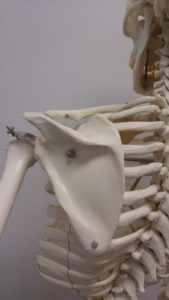 When rehabilitating the shoulder it is important to realise there is more than just the shoulder joint at play. Despite its name, very few people actually think of the shoulder blade as part of or related to the shoulder. Interestingly, it’s the shoulder blade that allows us to throw a cricket ball, reach for the top shelf at the supermarket and even brush our hair. When you lift your arm above your head, about a third of the movement comes from rotation of the shoulder blade (or scapula) which allows the arm to lift up high. Or if you think about this way, it is impossible to lift your arm above your head while keeping your shoulder blade still.
When rehabilitating the shoulder it is important to realise there is more than just the shoulder joint at play. Despite its name, very few people actually think of the shoulder blade as part of or related to the shoulder. Interestingly, it’s the shoulder blade that allows us to throw a cricket ball, reach for the top shelf at the supermarket and even brush our hair. When you lift your arm above your head, about a third of the movement comes from rotation of the shoulder blade (or scapula) which allows the arm to lift up high. Or if you think about this way, it is impossible to lift your arm above your head while keeping your shoulder blade still.
The muscles between the shoulder blade and arm bone (humerus) act to both stabilise and move the shoulder. This co-ordinated movement is referred to as ‘scapulohumeral rhythm’.
Scapulohumeral rhythm is a complex concept so allow me to break it down further…
Scapulohumeral rhythm was first defined by researches looking at the relationship of movement of the shoulder blade with movements of the arm. The shoulder has about 180 degrees of movement, and therefore requires a robust stabilising base of strong ligaments and muscles. These stabilising structures work best when they are at the perfect length, not over stretched nor too slack, so rotation of the scapula allows these muscles and ligament to stay within their optimal lengths.
As we lift our arm, the ratio of movement in the arm versus the shoulder blade is about 2:1. For example if we lift our arm as high as possible we can achieve roughly 180 degrees of movement, but of this only about 120 degrees comes from the actual shoulder joint, while the remaining 60 degrees is from the shoulder blade rotating.
Imagine the control Josh Hazlewood needs when bowling a pinpoint delivery, or how Stephanie Rice needed to get her arm into specific positions to pull water faster than her competitors. Essentially, the shoulder blade is an important anchor for muscles, a pivot point for movement of the arm, a bony shell for sensitive soft tissue structures, and an evolutionary marvel.
Poor shoulder blade stability is common in chronic shoulder conditions, and is a major cause of shoulder pain. When rehabilitating a shoulder injury, paying attention to the shoulder blade is just as important as the shoulder joint.
If you want to know more, or if you have shoulder issues, book in to our Sydney CBD clinic and see your Sports Physio at Bend + Mend.





